Installing solar panels in a school − or at least building your own mock-ups − isn’t as difficult as you might think, finds Josh Howgego
There was a member of parliament standing on the roof of the Royal Society of Chemistry’s main office in Cambridge last November. Julian Huppert doesn’t frequent such locations, I’m told, but this unusual event was sparked by the RSC installing 200 solar panels, capable of generating 50 kW of power at any given time. The MP for Cambridge was there for the unveiling ceremony.
Solar panels can provide a raft of benefits to an organisation or a household. They can save money on energy bills, decrease carbon footprints and, depending on your taste, make a roof look rather funky.
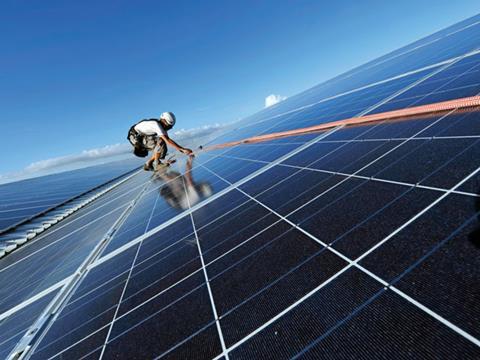
If you fancy getting in on the action, Ryan O’Connell could have an interesting proposition for you – especially if you happen to be in charge of a school. Solar panels are expensive and covering the roof of an averagely-sized school with photovoltaics could cost anywhere between £25,000 and £250,000, Ryan estimates. Once installed they can provide a valuable source of income, reduce schools’ energy bills and maybe even play a part in enthusing students about science. Yet that initial financial investment can be hard to stomach.
Ryan is a director of the Newmarket, UK-based company Evogreen that has a unique solution to this quandary. ‘We’re the only company in the UK that’s accredited to work with schools to install rented solar panels,’ he says. Schools are bound by a set of regulations that control the companies they can work with. Evogreen understands these principles, explains Ryan. It works with schools to develop a plan so that they can rent solar panels from the company, avoiding the need for a large amount of capital. They also ensure that the amount of money the school makes from the panels – in savings and from government subsidies – exceeds the rental payments. With this business model, everyone’s a winner: Evogreen get their rent and the school gets their solar panels and the associated benefits.
The ecoschool
Flegg High School, on the Norfolk broads, is one of the schools currently renting panels from Evogreen. ‘The first thing we did was have a pathfinder meeting with the school,’ says Ryan. ‘We call it that because this is a big project and we want to make sure we’re working together with the school to deliver what they want – not imposing anything on them.’
Even before Evogreen installed Flegg’s panels in 2013, the school was a certified ecoschool, meaning it had achieved accreditation from Eco-Schools, an international award programme designed to guide schools in their efforts to go green and embed environmentally sensitive principles into their communal life. Flegg had already installed a wood pellet burning boiler, and today it also has a wind turbine. The school was interested in ramping up its environmentally-friendly efforts when it approached Evogreen to enquire about photovoltaic panels.
Like most of Evogreen’s schemes, Flegg’s rental period lasts for 20 years, so the commitment is substantial. But the Evogreen team will sit down with the school and calculate all the earnings and savings they will make from their panels. Only when these overtake the rental fees does the plan go ahead.
Number crunching
Flegg opted for a set of panels that can generate up to 100 kW at their peak performance under the full glare of the sun. Such an output will account for roughly 20% of the school’s total requirements, estimates Ryan. Since the school was paying 10.7 p per kilowatt hour (kWh, the amount of energy expended if 1 kW is expended constantly for an hour), they will save a projected £9492 on their energy bills each year, according to Ryan’s calculations.
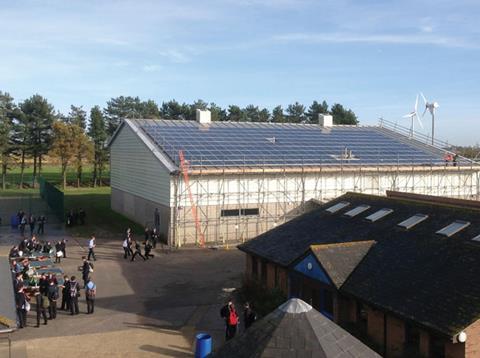
But that’s not the end of the benefits. The UK government pay what is called a feed-in tariff subsidy for energy that’s generated from renewable sources. This currently stands at 11.1 p per kWh, and when multiplied by the number of kWh the school will generate from its panels (forecast to be approximately 88,707), provides potential earnings of £9846 per year. Exactly how much better off Flegg is financially with these panels than without them is yet to be proven however because these are projected – not yet realised – figures.
A final thing that will be boosted is the school’s collective conscience, since Ryan estimates they will be saving 922 tonnes of carbon dioxide over 20 years. That’s equivalent to the amount of carbon absorbed by more than 90,000 trees in a year.
Persuading everyone to recognise that the installation has been a boon financially has been a challenge however, admits Flegg’s director of business and enterprise Ruth Bullard. ‘Some students and parents assume we have spent lots of money on the panels and that this would have been better spent on learning.’ In fact, says Ruth, savings and earnings from the panels ‘should enable us to spend more on the really important business of improving the outcomes for all our students’.
Green shoots
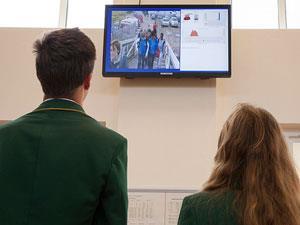
Ryan says an integral part of his company’s mission is to foster a green attitude in school pupils. ‘I’ve spoken in front of 900 pupils – which was quite terrifying,’ he says. ‘But it’s important we do things like that. Once the panels are in place we have an opportunity to capitalise on the interest it generates and foster students’ interest in the science of renewable energy.’
Several of Evogreen’s partner schools have installed real-time readouts from the panels. Ruth says these readouts provide an excellent on-site educational resource for her students. ‘They can see the panels working through live data feeds from them,’ she explains.
Evogreen also monitor the performance of their panels remotely from their offices and that data could be an interesting resource for students to plough through too. Ryan says his team at Evogreen is hoping to develop such ideas in collaboration with Eco-Schools in the coming year.
The solar spark
In the meantime there are plenty of ways schools can use solar panels to stir up an interest in science in their students. Don’t have any panels yet? Not a problem, says Neil Robertson, who runs an outreach initiative from the University of Edinburgh called The Solar Spark. There are still many ways to engage students using solar technology.
Neil is an active researcher in the area of solar technology himself, and founded The Solar Spark in 2009 when his research group joined teams from nine other UK universities in a large-scale research consortium. The Solar Spark was the outreach arm of the project, allowing researchers a platform on which to publish resources, and serving as a banner under which the scientists could head out to schools, learning centres and festivals in an effort to engage with the public.
That particular research project has now drawn to a close, but The Solar Spark’s website, which is chock-full of helpful teaching resources, is still continuing to evolve. Neil says he’s now focusing his team’s efforts partly on core professional development for teachers; offering training days for them at his university’s chemistry department. ‘There are so many schools it’s hard for us to make a big impact by visiting them individually,’ he says. And though the team have plans to visit several science festivals and schools in the coming months, Neil says that ‘if we train teachers, who can then go back and share what they’ve learned, that gives us a way of getting maximum impact with the volunteers available’.
Ideas on the website include a simple activity to make your own Grätzel cell. These solar cells, first developed by German scientist Michael Grätzel, are currently less well-suited for use in daylight than the solar panels Evogreen installs (see Solar cells explained). A simple version of a Grätzel cell is easy to make, explains Neil. ‘It’s literally Blue Peter level stuff,’ he says. ‘I often get someone from the audience to do it in an hour, while I give a public lecture’ (see Make your own Grätzel cell).
Make your own Grätzel cell
Making a basic Grätzel cell can take less than an hour and doesn’t require any particularly expensive equipment. You can even use pulped raspberries as the photon-absorbing dye. The other, easily sourceable, materials needed are fluorine-doped tin oxide glass slides, titanium dioxide paste and iodine solution. You’ll also need some basic laboratory equipment, including glass beakers, a stirrer-hotplate, crocodile clips, a torch, sticky tape and a graphite pencil. The Solar Spark’s website has full instructions.
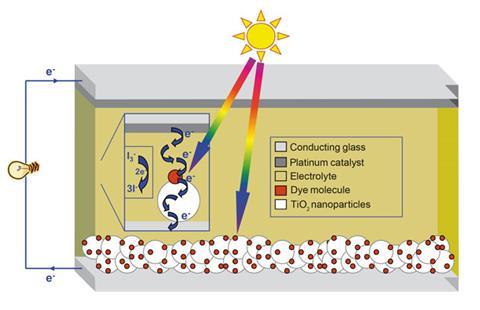
Young citizens’ science
So what does Neil think about the opportunities for students who are lucky enough to already have solar panels over their heads? ‘It’s fantastic,’ he says. ‘There is a move among educators – certainly here in Scotland with the new Curriculum for Excellence – to get students engaged in longer-term, research-based projects. So it’s not all about teaching facts, but how to think critically, look at real data and solve problems. And there’s especially a drive to that in areas that cross the traditional subject boundaries.’ Harnessing the data from solar panels above a classroom for students to use in projects could be an exciting exercise, according to Neil. Evogreen records such data as a matter of course, and can relay it to schools, so it’s feasible too.
There are all sorts of possibilities, says Neil. For example, data on power generation could be used as an input to bring simple physics calculations to life. But there is also scope for more in-depth projects, such as measuring the efficiency of installed panels, keeping track of the figures over time and correlating it with local weather and seasonal variations in climate.
In fact, such projects could provide insights of genuine interest to professional scientists. ‘It’s only in the last two or three years that solar panels have become really interesting for everyday people in the UK, because the economics has started to make sense,’ explains Neil. ‘So we’re only just starting to build a picture of real measurements on how well they perform in detail in the various microclimates across the UK. There has been a misconception among some that in Britain solar might not be that successful, but the data we have so far shows they are exceeding our expectations.’
Several projects, including one run by the University of Sheffield, are actively seeking householders and businesses alike who will share their photovoltaic output data. There remains gaping holes in this dataset, says Neil, especially when it comes to more isolated and rural regions.
With Evogreen’s attractive business model, there is no reason why lots of schools couldn’t sign up to have the technology installed, report the figures, and help the effort to record photovoltaic output. ‘It’s an incredibly exciting opportunity,’ enthuses Neil.
Joshua Howgego is a science journalist and writer based in London, UK
Solar cells explained
There are several types of solar cells. The rigid types you see on sloping roofs are usually crystalline silicon photovoltaics. These work well in daylight conditions, converting up to 20% of the energy that hits them into electric current. In the coming months, Evogreen are planning to begin offering monocrystalline panels, which contain a single large crystal instead of the multiple, interconnecting ones found in their more common polycrystalline cousins. Monocrystalline panels are a few % more efficient (and a little more expensive) than polycrystalline ones, so can be useful for schools with limited roof space.
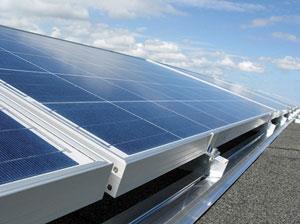
Nearly all commercial solar panels are of this type, but thin-film solar cells are also available. These work in a similar way to silicon cells, but their active component cadmium telluride absorbs light better, meaning the devices can be thinner and cheaper.
Then there are emerging technologies that are not yet commercially available. One example is the Grätzel cells. These are sometimes called dye-sensitised solar cells because they contain a coloured dye molecule that soaks up photons and releases a flow of electrons to make electricity. This type of solar cell can be printed out in flexible sheets using a roll-to-roll process similar to the type used to print newspapers. The downsides are that the cells currently available require a liquid electrolyte that can potentially leak from the cells after long periods of operation. And they generally convert less than 10% of incoming energy into electricity.
Organic photovoltaics, another emerging technology, differ from Grätzel cells in that they have no liquid components. Instead they include an organic polymer that conducts electricity. Some commentators have even wondered if they could be layered on the outside of buildings like a kind of energy-generating wallpaper. Like Grätzel cells, organic photovoltaics can be tuned to absorb different wavelengths of light, meaning they can operate indoors, scavenging light from the bulbs and screens we use on a day to day basis. Yet the downside of the cells is their efficiency: again, most don’t convert more than 10% of the light that hits them into electricity.









No comments yet